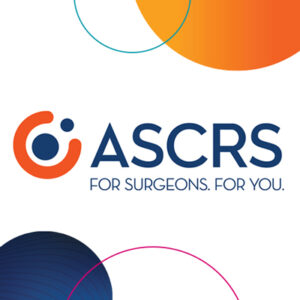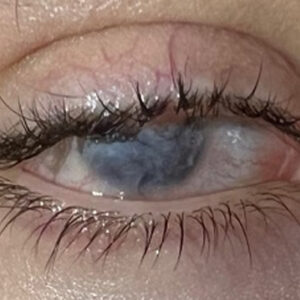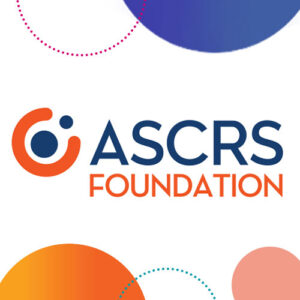Cataract
April 2022
by Liz Hillman
Editorial Co-Director
An IOL power miss—is it a complication or not?
The answer is nuanced. Some patients experience residual refractive error that is relatively significant and are still happy with their outcome, while others with a seemingly small residual refractive error are unhappy.
David Salz, MD, and H. John Shammas, MD, discussed why IOL power misses occur, what the options are for corrective action, and how to avoid such misses in the first place.

Dr. Shammas said an error in IOL power calculation is usually suspected when a patient presents postop with unexpected, induced myopia, hyperopia, or aniseikonia.
“When we first started using IOLs after cataract extraction 40 years ago, results within +/–2 D were acceptable and deemed superior to any aphakic correction. With the refinement of IOL formulas, patients and surgeons are now expecting a more accurate final refraction in the operated eye. Nowadays, 80% of our patients are expected to be within 0.50 D and 100% within 1 D,” he said.
However, Dr. Shammas noted that some patients with 1 D of error are happy with their results while patients with error as low as 0.5 D can be unhappy.
“It boils down to patient expectations,” he said.
Dr. Salz said that even patients off by as little as a quarter of a diopter can be unhappy if they are very sensitive about their vision.
“The misses we dwell on more are when patients are unhappy, though obviously we try to minimize any amount of error period,” he said.
Why misses occur
Dr. Salz said there is variability within different formulas that can be used to calculate IOL power.
“The reality is there is a margin of error for surgery with IOL calculations even with all the technology we now have,” he said.
Another source of variability is effective lens position. Formulas can try to predict effective lens position, but they’re not perfect, Dr. Salz said.
The number one source of error leading to IOL power misses, Dr. Salz said, occurs with biometry.
“Most physicians have some kind of optical biometry that they use, so most variability is with the corneal measurements, the steepness of the cornea. If those numbers are off a little bit—someone has dry eye, for example—the measurements of the cornea could be off because that’s one of the main things that goes into these calculations,” he said.
Dr. Shammas said most studies show that almost no errors occur over 1 D, but he still occasionally sees a referral with an error between 2 D and 5 D, resulting in myopia or hyperopia in the operated eye.
“Occasionally, we see the inadvertent use of a different power IOL due to human error,” he said, adding, “The most common cause is an error in axial length measurement. These errors are often seen in long or short eyes, especially if the eyes present with advanced cataracts that could not be measured by optical biometry; the technician will resort to measuring these eyes with ultrasound, with a greater possibility of error measurements.”
What options for ‘treatment’
First and foremost, Dr. Shammas said to identify the source of postoperative error.
- Recheck the power of the IOL against the calculated power to rule out human error. Dr. Shammas recommended the surgeon personally check the IOL power prior to implantation.
- Remeasure both eyes to rule out error in axial length measurement.
- Recalculate corneal power to rule out postoperative steepening of the cornea. Dr. Shammas said tight sutures can occasionally cause steepening.
- Assess the IOL’s position to rule out forward placement with or without tilt.
How to treat the eye with residual refractive error depends on the patient’s level of unhappiness, Dr. Salz said. If the refraction isn’t perfect but the patient is happy with the overall quality of vision, Dr. Salz said there is no reason to subject them to another procedure. Dr. Shammas said patients are more likely to complain if the error is in their dominant eye with an unexpected anisometropia and/or aniseikonia.
Dr. Salz said most patients with some residual refractive error are corrected with glasses. However, if a patient does not want glasses, there are other options.
“We’ll say, ‘The effective lens position ended up –0.5 in the other eye; I need to take that into account for the selection of the IOL power for the second eye,’” he explained.
Dr. Salz said he’s making this second eye adjustment in 5–10% of cases, though it’s not necessarily because the patient is unhappy. It’s because “I think I can get their other eye even better.”
Dr. Shammas said his practice follows a protocol based on a comprehensive study that found patients who had refractive error exceeding 0.5 D in their first eye could benefit from modifying the IOL power in the second eye.1 Dr. Shammas said this protocol can correct up to 50% of the error in the first eye. A study published earlier found that “accounting for 50% of the observed error of predicted refraction in the first eye reduced the error of predicted refraction in the second eye.”2
If a patient doesn’t want to move on to their second eye until they are happy with the vision in their first, Dr. Salz said options include IOL exchange (his preference in the immediate postop period unless there are issues precluding it), laser vision correction, or a piggyback lens (the latter is the least used of all the options, he said).
How to avoid misses in the first place
Dr. Salz said he always performs measurements on a different day than when the patient comes in for an exam or evaluation.
“It’s important for the cornea to be as pristine as possible. … If you put drops in the eye, you’re going to distort the surface,” he said, adding that if the patient is found to have dryness or blepharitis, that should be well treated before performing measurements.
He said if a patient has posterior subcapsular cataracts, it can be difficult to obtain accurate axial length measurements with optical biometry. Dr. Salz said if the patient wants to defer surgery for later, he’ll get axial length measurements earlier so he doesn’t need to do immersion A-scan later.
Dr. Shammas also noted that most misses are due to errors in axial length measurements, often due to advanced cataracts that cannot be measured with optical biometry.
“Newer biometers based on swept-source OCT, such as Argos [Alcon] or IOLMaster 700 [Carl Zeiss Meditec], have a much higher rate of acquisition, thus decreasing the need for ultrasound biometry. Also, these new biometers will display a two-dimensional B-scan image that can be used to ensure an accurate measurement has been performed,” he said.
Dr. Shammas said surgeons should review their measurements preoperatively and ensure the correct IOL power is used during surgery. This “cannot be underestimated,” he said.
About the physicians
David Salz, MD
The Eye Specialists
Bridgewater, New Jersey
H. John Shammas, MD
Shammas Eye Medical Center
Lynwood, California
References
- Jivrajka RV, et al. Improving the second-eye refractive error in patients undergoing bilateral sequential cataract surgery. Ophthalmology. 2012;119:1097–1101.
- Covert DJ, et al. Intraocular lens power selection in the second eye of patients undergoing bilateral, sequential cataract extraction. Ophthalmology. 2010;117:49–54.
Relevant disclosures
Salz: None
Shammas: Alcon, Oculus
Contact
Salz: dasalz@gmail.com
Shammas: hshammas@aol.com



